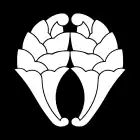Ōtomo clan
Ōtomo clan (大友氏, Ōtomo-shi) was a Japanese family whose power stretched from the Kamakura period through the Sengoku period, spanning over 400 years. The clan's hereditary lands lay in Kyūshū.
| Ōtomo clan 大友氏 | |
|---|---|
 The emblem (mon) of the Ōtomo clan | |
| Home province | Bungo Buzen |
| Titles | |
The first family head, Yoshinao (1172-1223), a descendant of the Fujiwara clan, took the name from the Ōtomo territory in Sagami province.
Following the establishment of the Kamakura shogunate in 1185, members of the clan were granted the post of Constable (Shugo) of Bungo and Buzen Provinces in Kyūshū.
As the Ōtomo were one of the major clans of Kyūshū, along with the Shōni and the Shimazu, they had a central role in organizing efforts against the Mongol invasions of Japan in 1274 and 1281.
They also played an important role in the establishment of the Ashikaga shogunate, in the 1330s. Ōtomo warriors fought alongside those of Ashikaga Takauji and enabled him to win a number of key battles, including the battle of Sanoyama; this helped to ensure them powerful government positions in the new shogunate.[1]
A powerful clan throughout the Sengoku period (1467–1573), the Ōtomo are especially notable as one of the first clans to make contact with Europeans, and to establish a trade relationship with them. In or around 1542, three Portuguese ships were carried by a typhoon to the island of Tanegashima, just off the coast of Kyūshū. Within ten years, trade with the Portuguese was fairly regular and common in Kyūshū. The Jesuit missionary Francis Xavier arrived in Japan in 1549, and soon afterwards met with Ōtomo Sōrin, shugo of Bungo and Buzen provinces, who would later be described by Xavier as a "king" and convert to Roman Catholicism in 1578. Ōtomo was eager to secure for his clan further trade and contact with the Portuguese, seeing the technological and, more importantly perhaps, economic benefits that could be derived. In 1552, emissaries from the Ōtomo clan traveled to Goa with Xavier, to meet with the Portuguese Governor of India. Xavier and other Jesuit missionaries would return to Kyūshū, traveling and proselytizing; the Ōtomo were always well-disposed towards them, and they saw some success in Bungo as a result, converting many Japanese to Christianity.
Towards the end of the 16th century, the Ōtomo fought both the Shimazu and Mōri clans, the latter of whom were expert sailors. Though they did not play a major role in the campaigns of Tokugawa Ieyasu which ended the Sengoku period, they did retain their domains into the Edo period.
Clan Heads
- Ōtomo Yoshinao (大友能直, 1172–1223)
- Ōtomo Chikahide (大友親秀, 1195–1248)
- Ōtomo Yoriyasu (大友頼泰, 1222–1300)
- Ōtomo Chikatoki (大友親時, 1236–1295)
- Ōtomo Sadachika (大友貞親, 1246–1311)
- Ōtomo Sadamune (大友貞宗, ? –1334)
- Ōtomo Ujiyasu (大友氏泰, 1321–1362)
- Ōtomo Ujitoki (大友氏時, ? –1368)
- Ōtomo Ujitsugu (大友氏継, ? –1401)
- Ōtomo Chikayo (大友親世, ? –1418)
- Ōtomo Chikaaki (大友親著, ? –1426), also called "Chikatsugu".
- Ōtomo Mochinao (大友持直, ? –1445)
- Ōtomo Chikatsuna (大友親綱, ? –1459)
- Ōtomo Chikataka (大友親隆, ? –1470)
- Ōtomo Chikashige (大友親繁, 1411–1493)
- Ōtomo Masachika (大友政親, 1444–1496)
- Ōtomo Yoshisuke (大友義右, 1459–1496)
- Ōtomo Chikaharu (大友親治, 1461–1524)
- Ōtomo Yoshinaga (大友義長, 1478–1518)
- Ōtomo Yoshiaki (大友義鑑, 1502–1550)
- Ōtomo Sōrin (大友宗麟, 1530–1587), originally Ōtomo Yoshishige (大友義鎮)
- Ōtomo Yoshimune (大友義統, 1558–1610)
- Ōtomo Yoshinori (大友義乗, 1577–1612)
- Ōtomo Yoshichika (大友義親, 1597–1619)
Notable Members
- Ōtomo no Kuronushi – classical poet
- Ōtomo-Nata Jezebel (d. 1587) – High priestess of Usa Jingū, wife of Ōtomo Sōrin and mother of Ōtomo Yoshimune
- Myorin - Lady of Tsurusaki Castle
- Ōtomo Sōrin (1530–1587), Constable of Bungo and Buzen Provinces
- Ōtomo Yoshimune (1558–1610), heir of Otomo Sorin.
- Ōuchi Yoshinaga (1532 – May 1, 1557), the younger brother of Ōtomo Yoshishige.
Popular culture
Otomo is a playable nation in the grand strategy games Europa Universalis IV, Sengoku as well as in Shogun 2.[2][3]
See also
References
- Sansom, George (1961). A History of Japan, 1334–1615. Stanford University Press. pp. 40–41, 48. ISBN 0804705259.
- http://store.steampowered.com/app/223180/
- http://www.eu4wiki.com/Japan#List_of_daimyo
- Turnbull, Stephen (1998). The Samurai Sourcebook. London: Cassell & Co.